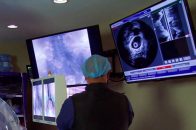The American College of Cardiology/American Heart Association (ACC/AHA) have recently published primary prevention cardiovascular disease guidelines. They were originally considered very useful for general practitioners who had no choice but to review separately expert consensus or clinical practice guidelines for hypertension, cholesterol, diabetes, etc. Now, everything is concentrated in a single reference document. But is…
Amount of Baseline Ischemia in Patients with Multivessel Disease and Long-Term Progress
According to this recent analysis of the MASS II trial, which will soon be published in JAMA, baseline ischemia is not associated with events at 10 years in patients with chronic stable angina. The ischemic burden induced through exercise does not predict events or long-term ventricular function. Such data add some suspense to the results…
How to Prevent Pharmacological Overtreating in the Elderly
Cardiovascular risk increases dramatically with over the years, which almost inevitable leads to treating the elderly with statins, based on risk. To prevent over treatment, we need to identify fragile patients (bed-ridden or with dementia), whose condition might make this treatment futile on the one hand, and on the other hand, patients who regardless their…
Functional Assessment of Lesions: Advances with MRI
Computer tomography (CT) had taken over in the race to develop software capable of measuring FFR non-invasively. Magnetic resonance imaging (MRI) wouldn’t fall behind and has also tried non-inferiority vs an FFR based strategy, according to this study recently published in the prestigious NEJM, called MR-INFORM. In patients with chronic angina and CAD risk factors,…
What Happens When We Are Blinded by Left Main Disease and Ignore All Other Lesions?
According to this recent Excel analysis, mortality seems to rise when the SYNTAX II score is not taken into account when defining the revascularization strategy. The difference does not reach statistical significance and further studies are required, but the message is clear: the left main coronary artery is not the only thing that matters; other…
Aspirin in Primary Prevention: Another “Trendy” Topic in Publications
Aspirin is the standard treatment when it comes to optimal medical treatment in the context of secondary prevention of coronary artery disease, in patients with diagnosed, established atherosclerosis. Even though bleeding risk is rather small in the short period an acute event takes place, it increases substantially over time. However, the evidence clearly supports the…
EuroPCR 2019 | BASKET-SMALL 2: Drug-Coated Balloons vs. DES in Small Vessels
This angiographic substudy supports the safety of drug-coated balloons in small vessels. Despite better angiographic outcomes, there were eight cases of stent thrombosis among drug-eluting stent (DES) patients, while there was none with drug-coated balloons. In patients with small vessels, using a drug-coated balloon appears safe and comparable to DES, with favorable angiographic outcomes at…
EuroPCR 2019 | Intravascular Imaging Almost Indispensable for Planning an Angioplasty
Cost and time are the two main enemies of intravascular imaging, but lack of expertise may also play a role. A new European Association of Percutaneous Cardiovascular Interventions (EAPCI) expert consensus statement released at EuroPCR 2019 argues that there is a need for more use of intracoronary imaging in settings of acute coronary syndromes and…
Nonobstructive Coronary Lesions and Ventricular Dysfunction
Many patients arrive to the cath lab for a diagnostic coronary angiography after an echo showing severe ventricular dysfunction, even in asymptomatic patients. In many occasions, their coronary arteries are normal, and in many others, we find coronary disease that is not enough to warrant such severe ventricular dysfunction. Patients with heart failure are frequently…
Angiography Guided CABG Still Adequate
Fractional Flow reserve (FFR) guided myocardial revascularization surgery (CABG) has similar graft failure rate and clinical outcomes as angiography guided CABG. When planning PCI, the value of FFR for lesion assessment pose no questions, but we know little when it comes to CABG. Since the early start, back when Dr. Mason Sones performed catheterizations and…
Balancing Bleeding Risk vs. Thrombotic Risk to Define Dual Antiplatelet Therapy Duration
Patients who undergo complex angioplasty are at higher ischemic risk, but only benefit from extended dual antiplatelet therapy if there are no factors for high bleeding risk. These data suggest that the bleeding risk must weigh more than the ischemic risk on the determination of dual antiplatelet therapy duration. Complex angioplasty is associated with higher…










